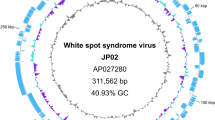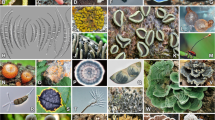Abstract
Application of the amplified fragment length polymorphism (AFLP) technique to genetic mapping studies requires high quality DNA as a template. In the case of Eimeria spp., this has previously been in the form of chromosomal DNA obtained from purified sporozoites recovered from large numbers of oocysts (generally up to 2×108). In order for the AFLP technique to be more easily applied to studies on the genetics of Eimeria maxima, for which only smaller numbers of oocysts are available, a simplified, more efficient method for the recovery of genomic DNA from small numbers of oocysts was developed. Our new method should also be useful for genetic analyses of other coccidial parasites and for the recovery of AFLP-quality DNA from other pathogens.

Similar content being viewed by others
References
Aarts H, van Lith L, Keijer J (1998) High-resolution genotyping of Salmonella strains by AFLP-fingerprinting. Lett Appl Microbiol 26:131–135
Ajmone-Marsan P, Valentini A, Cassandro M, Vecchiotti-Antaldi G, Bertoni G, Kuiper M (1997) AFLP markers for DNA fingerprinting in cattle. Anim Genet 28:418–426
Grech K, Martinelli A, Pathirana S, Walliker D, Hunt P, Carter R (2002) Numerous, robust genetic markers for Plasmodium chabaudi by the method of amplified fragment length polymorphism. Mol Biochem Parasitol 123:95–104
Long P, Joyner L, Millard B, Norton C, (1976) A guide to laboratory techniques used in the study and diagnosis of avian coccidiosis. Folia Vet Lat 6:201–217
Meksem K, Leister D, Peleman J, Zabeau M, Salamini F, Gebhardt C (1995) A high-resolution map of the vicinity of the r1 locus on chromosome v of potato based on RFLP and AFLP markers. Mol Gen Genet 249:74–81
Mougel C, Thioulouse J, Perriere G, Nesme X (2002) A mathematical method for determining genome divergence and species delineation using AFLP. IntJ Syst Evol Microbiol 52 (Pt 2):573–586
Sambrook J, Russell D (2001) Molecular cloning: a laboratory manual.Cold Spring Harbor Laboratory Press, Cold Spring Harbor, N.Y.
Shirley M, Harvey D (2000) A genetic linkage map of the apicomplexan protozoan parasite Eimeria tenella. Genome Res 10:1587–1593
Shirley M, Kemp D, Pallister J, Prowse S (1990) A molecular karyotype of Eimeria tenella as revealed by contour-clamped homogenous electric field gel electrophoresis. Mol Biochem Parasitol 38:169–174
Vos P, Hogers R, Bleeker M, Reijans M, van de Lee T, Hornes M, Frijters,A, Pot J, Peleman J, Kuiper M, Zabeau M (1995) AFLP: a new technique for DNA fingerprinting. Nucleic Acids Res 23:4407–4414
Acknowledgements
The authors wish to acknowledge the technical assistance of Fionnadh Carroll, Pat Hesketh and Andrew Archer. The Biotechnology and Biological Sciences Research Council financially supported this study under grant 201/S15343. The experiments performed in this study comply with UK and EU law.
Author information
Authors and Affiliations
Corresponding author
Rights and permissions
About this article
Cite this article
Blake, D.P., Smith, A.L. & Shirley, M.W. Amplified fragment length polymorphism analyses of Eimeria spp.: an improved process for genetic studies of recombinant parasites. Parasitol Res 90, 473–475 (2003). https://doi.org/10.1007/s00436-003-0890-x
Received:
Accepted:
Published:
Issue Date:
DOI: https://doi.org/10.1007/s00436-003-0890-x




